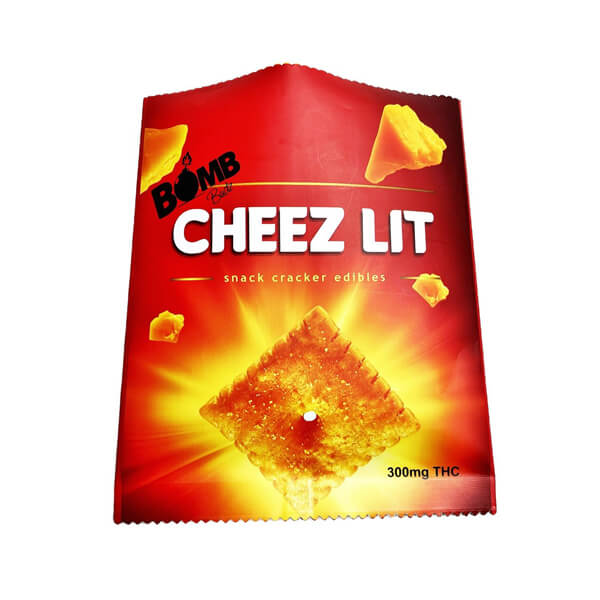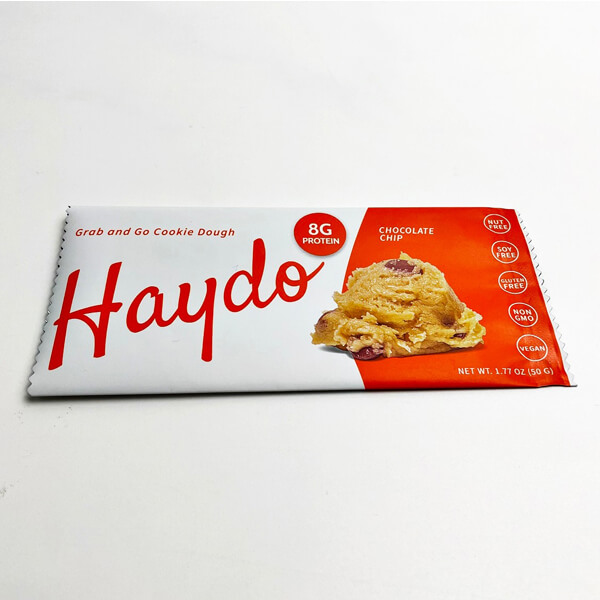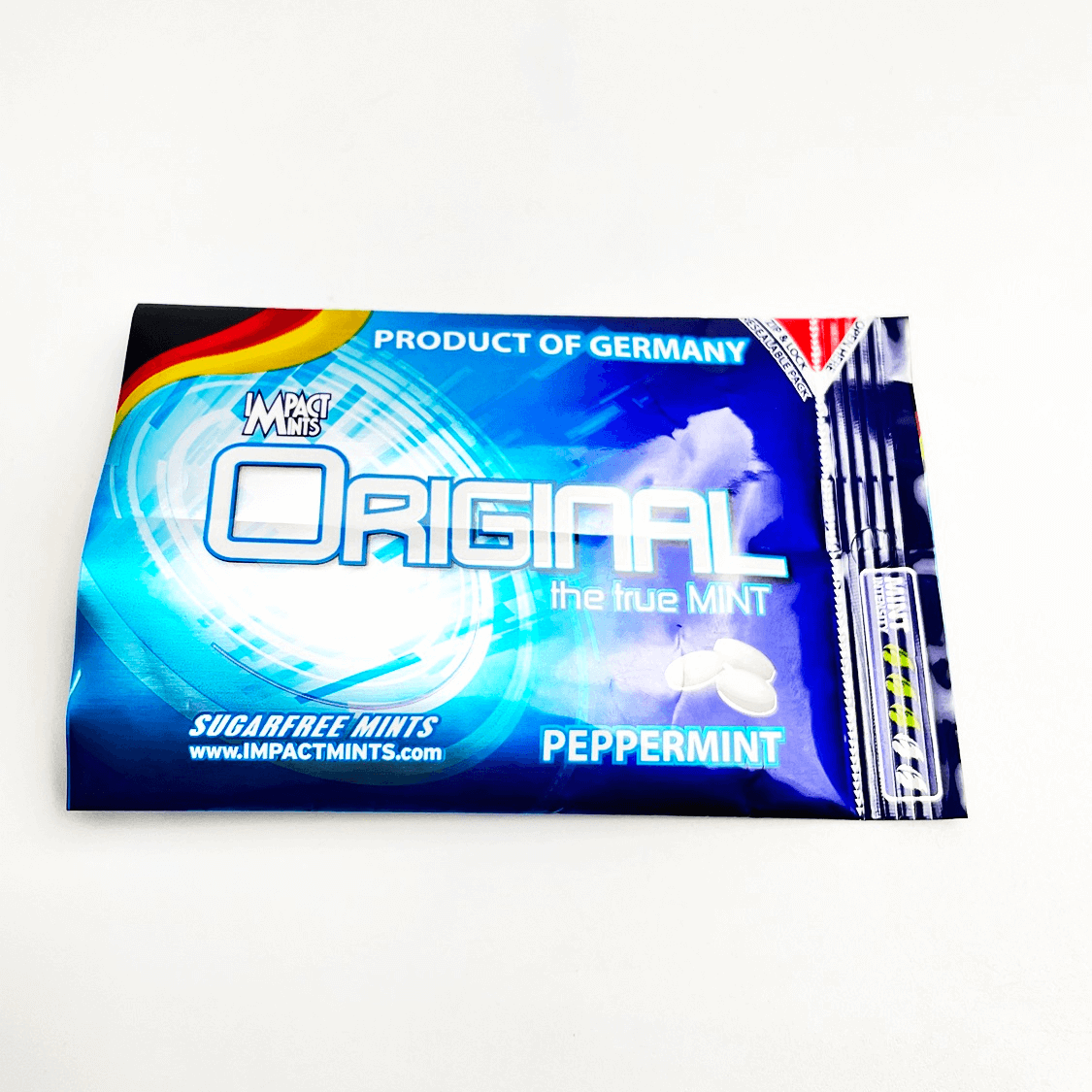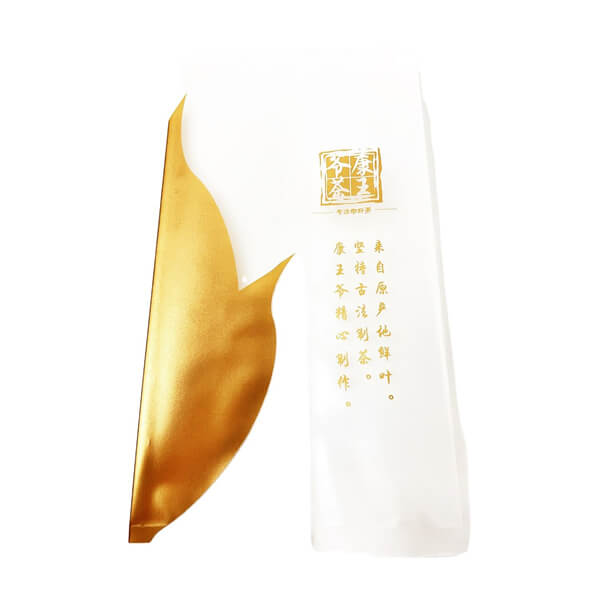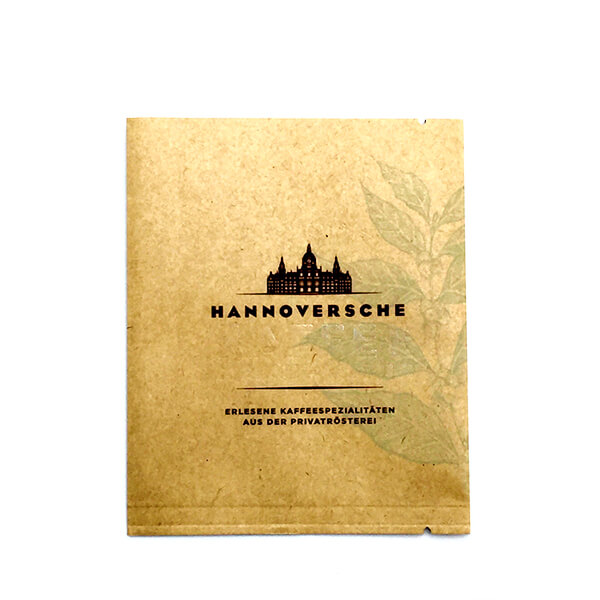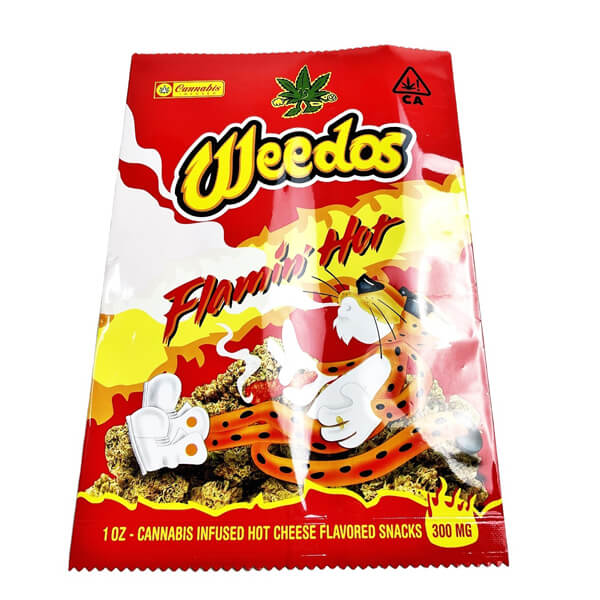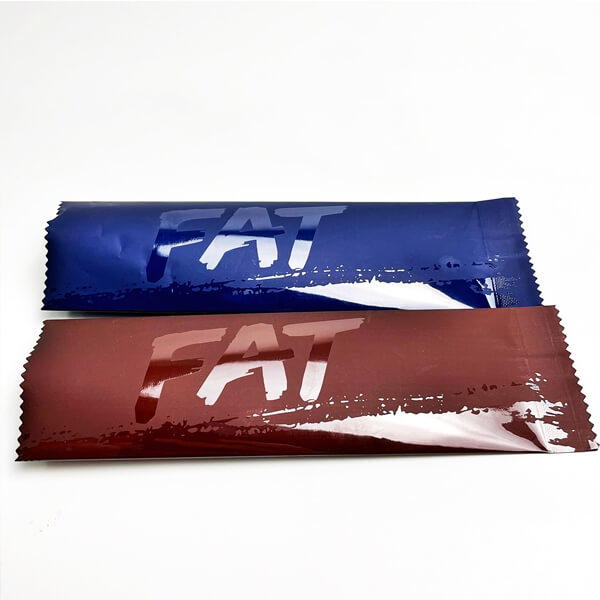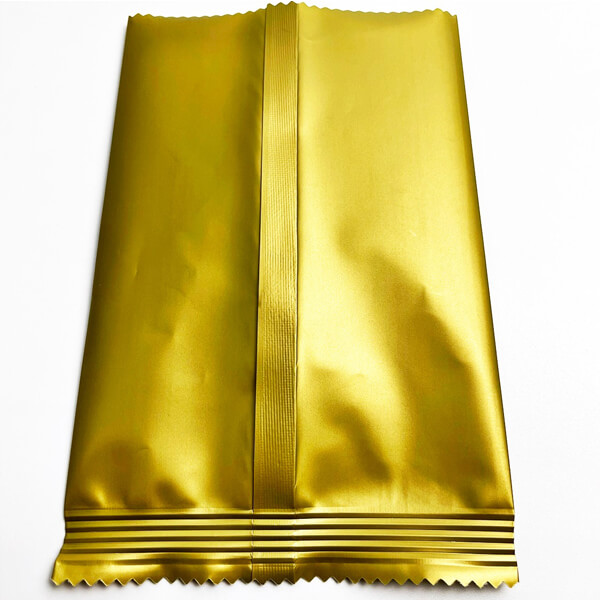Home » Bags & Pouches » Fin Seal Pouches » Fin Seal Pouch For Bar Packaging
Fin Seal Pouch For Bar Packaging
Custom fin seal bags for bar packaging are pouches that feature a seal that runs the length of one side, which is often referred to as the fin. Primarily for the snack food industry, food bars, and trading cards.
Please note that we have a MOQ for our pouch. For pouches in stock, the MOQ is 500 pcs. For customized pouches, please see the MOQ as followed:
1, Digital Printing — 500 pcs
2, Gravure Printing — 5,000pcs
Rinpac assists you throughout your project: bag shape, material, thickness, capacity and printing options. Please contact us or mark your requirements on the inquiry quotation.
Order single or thousands of items at a time. Our warehouse and flexible shipping options are available for last-minute, deadline critical orders.
- Free Sample
*Customization is always available, please mark down your need in cart or just contact us.
Specification
| MOQ | 500 PCS |
| Size | Per customer’s request |
| Material | BOPP/PET+PET/PETAL/Kraft Paper/+LLDPE/CPP |
| Thickness | 50Mircons-120Mircons (2Mil-5Mil) |
| Function | Punch Hole, Handle, Metallized |
| Printing | D-Met Printing, Vanishing, Matte Finishing, Stamping |
| Features & Benefits | Re-sealable or single-use Top and bottom seal Backfin seal More product, less material |
| Custom Order | Accept |
Video
Request A Qoute
Need something helped in a short time? We’ve got a plan for you.
Introduction to Fin Seal Pouches
Fin seal pouches, also known as pillow pouches or flow wrap pouches, are a popular packaging solution known for their versatility and convenience. These pouches are widely used across various industries, including food, pharmaceuticals, and consumer goods, due to their ability to accommodate a wide range of products while providing excellent protection and presentation.
The defining feature of fin seal pouches is the fin or back seal running along the length of the pouch, which creates a secure closure and maximizes product freshness. This sealing method ensures that the contents are safely enclosed within the pouch, minimizing the risk of contamination or spoilage.
Fin seal pouches are typically constructed using multiple layers of flexible materials, such as plastic films, barrier films, and sealant layers. These layers are laminated together to create a durable and protective packaging structure that preserves the quality and integrity of the enclosed products.
One of the key advantages of fin seal pouches is their ability to accommodate various product shapes and sizes, ranging from individual items to bulk quantities. Whether it’s packaging snacks for on-the-go consumption, storing pharmaceutical tablets, or protecting retail products on shelves, fin seal pouches offer a versatile and efficient packaging solution.
In addition to their functional benefits, fin seal pouches also provide opportunities for branding and customization. Businesses can leverage custom printing and design options to enhance the visual appeal of their packaging, reinforce brand identity, and attract consumers’ attention on store shelves.
Overall, fin seal pouches are an integral part of modern packaging solutions, offering versatility, protection, and presentation for a wide range of products. With their secure seal and customizable features, fin seal pouches meet the diverse packaging needs of businesses while ensuring product freshness and consumer satisfaction.
Benefits of Using Fin Seal Pouches for Bar Packaging
Fin seal pouches offer several benefits for packaging bars, including convenience, versatility, enhanced product protection, and branding opportunities. Here’s a closer look at the advantages of using fin seal pouches for bar packaging:
Convenience and Versatility
Easy to Open and Re-Seal: Fin seal pouches are designed for easy opening and re-sealing, providing convenience for consumers who want to enjoy their bars on-the-go and save the rest for later.
Portion Control: Individual bars can be packaged in fin seal pouches, allowing for portion control and convenient snacking, whether at home, in the office, or while traveling.
Accommodate Various Bar Sizes: Fin seal pouches come in various sizes, making them suitable for packaging different bar sizes and shapes, from granola bars to protein bars and chocolate bars.
Enhanced Product Protection
Secure Seal: The fin seal along the back of the pouch creates a secure closure that protects the bars from external elements such as moisture, air, and light, preserving their freshness and flavor.
Barrier Properties: Fin seal pouches can be made with barrier films that provide additional protection against oxygen and humidity, extending the shelf life of the bars and maintaining their quality over time.
Tamper-Evident Features: Some fin seal pouches come with tamper-evident features such as tear notches or tamper-proof seals, ensuring product integrity and safety until opened by the consumer.
Branding Opportunities
Custom Printing: Fin seal pouches offer ample space for custom printing, allowing brands to showcase their logos, brand colors, and product information prominently on the packaging, enhancing brand visibility and recognition.
Eye-Catching Design: Vibrant graphics and attractive designs on fin seal pouches can grab consumers’ attention on store shelves, enticing them to choose the packaged bars over competitors’ products.
Differentiation: Customized fin seal pouches enable brands to differentiate their bars from others in the market, creating a unique identity and appealing to consumers’ preferences and tastes.
In summary, fin seal pouches offer numerous benefits for bar packaging, including convenience, enhanced product protection, and branding opportunities. With their versatility and customizable features, fin seal pouches provide an efficient and attractive packaging solution that meets the needs of both brands and consumers.
Materials Used in Fin Seal Pouches
Fin seal pouches are constructed using a variety of materials to ensure durability, barrier protection, and product freshness. Two common types of materials used in fin seal pouches include:
Plastic Films
Plastic films are widely used in the production of fin seal pouches due to their flexibility, durability, and cost-effectiveness. Some common types of plastic films include:
Polyethylene (PE): PE films are versatile and offer good moisture resistance, making them suitable for packaging a wide range of products, including snacks, confectionery items, and pharmaceuticals.
Polypropylene (PP): PP films provide excellent clarity and heat resistance, making them ideal for applications where visibility of the packaged product is important, such as candy bars and snack packaging.
Polyester (PET): PET films offer high tensile strength and barrier properties, making them suitable for packaging products that require protection against oxygen and moisture, such as chocolate bars and dried fruits.
Foils
Foils are often laminated with plastic films to create barrier layers that provide additional protection against moisture, oxygen, and light. Some common types of foils used in fin seal pouches include:
Aluminum Foil: Aluminum foil is widely used for its excellent barrier properties, heat resistance, and light-blocking capabilities. It helps to preserve the freshness and flavor of packaged products, such as granola bars, by preventing exposure to external elements.
Metalized Films: Metalized films consist of a thin layer of metal deposited onto a plastic substrate, providing barrier properties similar to aluminum foil but with reduced weight and cost. Metalized films are commonly used in snack packaging, candy bars, and other food products.
In summary, fin seal pouches are typically made from a combination of plastic films and foils to provide the necessary barrier protection and product integrity. By selecting the appropriate materials based on the specific packaging requirements, manufacturers can ensure that fin seal pouches effectively protect and preserve the quality of the packaged products.
Design Options for Fin Seal Pouches
Fin seal pouches offer a range of design options and customizable features to enhance brand visibility and attract consumers’ attention. From customizable features to graphics and printing techniques, here are the design options available for fin seal pouches:
Customizable Features
Zipper Closures: Zipper closures provide convenience for consumers by allowing them to reseal the pouch after opening, ensuring product freshness and preventing spillage.
Tear Notches: Tear notches facilitate easy opening of the pouch without the need for scissors or other tools, enhancing consumer convenience and usability.
Hang Holes: Hang holes allow fin seal pouches to be displayed on peg hooks or racks in retail environments, maximizing visibility and shelf space utilization.
Graphics and Printing Techniques
Custom Printing: Fin seal pouches can be custom printed with brand logos, product information, and eye-catching graphics to enhance shelf appeal and brand recognition.
Vibrant Colors: High-quality printing techniques enable the use of vibrant colors and attractive designs on fin seal pouches, grabbing consumers’ attention and enticing them to make a purchase.
Matte or Glossy Finishes: Matte or glossy finishes add a premium look and feel to fin seal pouches, enhancing their visual appeal and perceived value on store shelves.
Special Effects: Special printing effects such as metallic accents, embossing, or spot varnishes can be applied to fin seal pouches to create a unique and memorable packaging design.
By leveraging these design options and customizable features, brands can create fin seal pouches that stand out in crowded retail environments, communicate key brand messages, and engage consumers effectively.
Manufacturing Process of Fin Seal Pouches
The manufacturing process of fin seal pouches involves several steps, including film extrusion, printing, lamination, and pouch forming and sealing. Here’s an overview of each stage in the process:
Film Extrusion
Resin Preparation: The process begins with the preparation of raw resin materials, such as polyethylene (PE), polypropylene (PP), or polyester (PET), which are used to produce the film layers of the pouch.
Extrusion: The resin materials are melted and extruded through a die to form a continuous sheet of plastic film. The thickness and properties of the film can be adjusted during the extrusion process to meet specific requirements for barrier properties, clarity, and strength.
Printing
Pre-Press Preparation: Artwork and design files are prepared for printing, including brand logos, product information, and graphics. Color separations and printing plates are created to transfer the designs onto the film.
Printing: The printed film is fed through a printing press, where the designs are transferred onto the surface of the film using various printing techniques, such as flexography, gravure, or digital printing. Multiple colors and intricate graphics can be applied to the film during the printing process.
Lamination
Adhesive Application: In the lamination process, a layer of adhesive is applied to one or both sides of the printed film. The adhesive helps bond the printed film to other layers of film or foil to create a multi-layered structure with enhanced barrier properties.
Laminating: The printed film is combined with other layers of film or foil, such as aluminum foil or barrier films, to create a laminate structure. The layers are passed through heated rollers under pressure to bond them together, forming a strong and durable composite material.
Pouch Forming and Sealing
Pouch Forming: The laminated film is fed into a pouch forming machine, where it is cut into individual pouches of the desired size and shape. The pouches are then folded and sealed along the edges to create a sealed pouch with a fin seal running along the back.
Sealing: The edges of the pouch are sealed using heat and pressure to create a secure closure. The fin seal provides additional strength and protection, ensuring that the contents are safely enclosed within the pouch.
Once the pouches are formed and sealed, they can be filled with the desired product, such as candies, snacks, or pharmaceuticals, before being packaged and distributed to retailers or consumers.
Sustainability Aspects of Fin Seal Pouches
Fin seal pouches offer several sustainability aspects that contribute to environmental conservation and resource efficiency. Key sustainability aspects of fin seal pouches include recyclability and reduced material usage:
Recyclability
Polyethylene (PE) and Polypropylene (PP) Films: Fin seal pouches are commonly made from recyclable materials such as polyethylene (PE) and polypropylene (PP) films. These materials can be collected, processed, and recycled through existing waste management systems, reducing the amount of plastic waste sent to landfills.
Recycling Infrastructure: Many regions have established recycling infrastructure for plastics, including PE and PP films used in fin seal pouches. Consumers can recycle empty pouches along with other plastic packaging materials, contributing to the circular economy and conserving natural resources.
Reduced Material Usage
Lightweight Design: Fin seal pouches are designed to be lightweight, using minimal material compared to rigid packaging options such as bottles or jars. This reduced material usage helps conserve raw materials and reduces the environmental impact associated with packaging production and transportation.
Optimized Packaging Efficiency: The flexible and customizable nature of fin seal pouches allows for efficient use of packaging materials, minimizing excess packaging and optimizing packaging efficiency. This results in reduced material waste and lower carbon emissions throughout the packaging lifecycle.
Source Reduction: Fin seal pouches offer opportunities for source reduction by eliminating the need for additional packaging components such as lids, caps, or seals. This simplifies the packaging design and reduces the overall environmental footprint of the packaging system.
By prioritizing recyclability and reducing material usage, fin seal pouches contribute to sustainable packaging practices and support efforts to minimize plastic waste and environmental pollution. As consumers and businesses increasingly prioritize sustainability, fin seal pouches offer a viable packaging solution that balances product protection, convenience, and environmental responsibility.
Applications of Fin Seal Pouches in Bar Packaging
Fin seal pouches are widely utilized in the packaging of various types of bars, providing convenience, protection, and branding opportunities. Here are some common applications of fin seal pouches in bar packaging:
Protein Bars
Portion Control: Fin seal pouches are ideal for packaging individual protein bars, allowing for portion control and on-the-go consumption. Consumers can easily carry and enjoy protein bars as a convenient snack or post-workout fuel.
Product Freshness: The secure seal of fin seal pouches helps preserve the freshness and flavor of protein bars, extending their shelf life and maintaining their nutritional value over time.
Branding Opportunities: Custom printing options enable brands to showcase their logos, product features, and health benefits on the packaging, enhancing brand visibility and communicating key messages to consumers.
Energy Bars
Convenience: Fin seal pouches offer convenience for packaging energy bars, allowing consumers to grab and go without the need for additional packaging or utensils. This makes energy bars an ideal snack option for busy lifestyles and on-the-go activities.
Protection from External Elements: The barrier properties of fin seal pouches protect energy bars from moisture, air, and light, ensuring product freshness and integrity throughout the packaging and distribution process.
Customization: Brands can customize the design and graphics of fin seal pouches to reflect the energy-boosting properties of their bars, using vibrant colors and imagery to attract consumers’ attention and convey a sense of vitality and wellness.
Granola Bars
Versatility: Fin seal pouches accommodate various types of granola bars, including chewy, crunchy, and coated varieties, providing flexibility for brands to offer a diverse range of flavors and textures to consumers.
Preservation of Crunchiness: The sealed packaging of fin seal pouches helps retain the crunchiness and texture of granola bars, ensuring a satisfying snacking experience for consumers.
On-Shelf Visibility: Eye-catching designs and branding elements on fin seal pouches enhance the visibility of granola bars on store shelves, attracting consumers’ attention and encouraging purchase decisions.
In summary, fin seal pouches are versatile and effective packaging solutions for protein bars, energy bars, and granola bars, offering convenience, protection, and branding opportunities for brands and consumers alike.
Market Trends and Growth of Fin Seal Pouches
In recent years, fin seal pouches have experienced significant growth and adoption across various industries, driven by several key market trends. Here are the current market trends shaping the growth of fin seal pouches:
Rise in Demand for Convenient Packaging Solutions
On-the-Go Lifestyles: The growing prevalence of on-the-go lifestyles has led to increased demand for convenient and portable packaging solutions, such as fin seal pouches. Consumers seek snacks and other products that are easy to carry and consume while commuting, traveling, or engaging in outdoor activities.
Single-Serve Packaging: The trend towards single-serve packaging options aligns with the convenience factor, as consumers prefer portion-controlled servings that minimize waste and offer convenience for snacking occasions.
Emphasis on Sustainable Packaging
Environmental Awareness: With heightened awareness of environmental issues and plastic pollution, there is a growing demand for sustainable packaging solutions. Fin seal pouches made from recyclable materials and offering reduced material usage are increasingly favored by environmentally conscious consumers and businesses.
Eco-Friendly Innovations: Manufacturers are investing in eco-friendly innovations, such as biodegradable films and compostable materials, to meet the demand for sustainable packaging options. These initiatives aim to reduce the environmental impact of packaging waste and support circular economy principles.
Diversification of Product Offerings
Expanded Applications: Fin seal pouches are expanding beyond traditional applications in food and beverage packaging to include a broader range of products, such as pharmaceuticals, personal care items, and household goods. This diversification of product offerings contributes to the growth and versatility of fin seal pouches in the market.
Customization and Branding: Brands are leveraging the customizable features of fin seal pouches to differentiate their products and create unique packaging experiences for consumers. Custom printing, vibrant colors, and innovative designs help brands stand out on store shelves and attract consumer attention.
Technological Advancements
Advanced Packaging Equipment: Technological advancements in packaging machinery, such as improved sealing systems and automation capabilities, enhance the efficiency and productivity of fin seal pouch production. These advancements enable manufacturers to meet growing demand while maintaining product quality and consistency.
Smart Packaging Solutions: Integration of smart packaging technologies, such as RFID tags and QR codes, provides opportunities for enhanced traceability, authentication, and consumer engagement. Smart features add value to fin seal pouches by delivering real-time information and interactive experiences for consumers.
Overall, the market trends driving the growth of fin seal pouches reflect evolving consumer preferences, industry innovations, and sustainability initiatives. As demand for convenient, sustainable, and versatile packaging solutions continues to grow, fin seal pouches are poised to remain a prominent choice for brands across various sectors.
Challenges and Considerations in Using Fin Seal Pouches
Despite their many advantages, the use of fin seal pouches presents certain challenges and considerations that businesses must address to ensure successful packaging solutions. Here are some key factors to consider:
Barrier Properties
Material Selection: Choosing the appropriate film materials with the right barrier properties is crucial to prevent oxygen, moisture, and light from permeating the pouch and affecting the quality and shelf life of the packaged products.
Barrier Integrity: Maintaining the integrity of the barrier throughout the manufacturing process, including printing and sealing, is essential to ensure consistent protection for the contents of the fin seal pouches.
Shelf Life
Product Compatibility: Certain products may have specific shelf life requirements that need to be considered when selecting fin seal pouches. Factors such as product composition, moisture sensitivity, and susceptibility to oxidation can influence shelf life considerations.
Storage Conditions: Proper storage conditions, including temperature and humidity control, are essential for preserving the shelf life of products packaged in fin seal pouches. Improper storage can accelerate deterioration and compromise product quality.
Cost Considerations
Material Costs: The cost of raw materials, including film materials and barrier coatings, can impact the overall cost of manufacturing fin seal pouches. Balancing cost considerations with performance requirements is essential for achieving cost-effective packaging solutions.
Production Efficiency: Maximizing production efficiency and minimizing waste during the manufacturing process can help reduce production costs associated with fin seal pouches. Optimizing equipment, workflow, and quality control measures can contribute to cost savings.
Environmental Impact
Material Selection: Considering the environmental impact of the materials used in fin seal pouches, such as recyclability and biodegradability, is becoming increasingly important in response to consumer demand for sustainable packaging options.
End-of-Life Management: Implementing recycling programs and promoting responsible disposal practices for fin seal pouches can help minimize their environmental footprint and support circular economy principles.
Addressing these challenges and considerations requires careful planning, collaboration with packaging suppliers, and adherence to industry best practices. By understanding the factors influencing barrier properties, shelf life, cost considerations, and environmental impact, businesses can optimize their use of fin seal pouches to meet the needs of consumers while ensuring product quality, sustainability, and cost-effectiveness.
Future Outlook and Innovations in Fin Seal Pouches
The future of fin seal pouches is bright, with ongoing innovations and advancements poised to enhance their performance, sustainability, and versatility. Here’s a look at the future outlook and emerging trends in fin seal pouch technology:
Innovations in Materials
Advanced Barrier Films: Continued research and development efforts are focused on enhancing the barrier properties of film materials used in fin seal pouches. Innovations in barrier coatings and multilayer structures will improve protection against oxygen, moisture, and light, extending the shelf life of packaged products.
Biobased and Biodegradable Materials: The shift towards sustainable packaging solutions will drive the adoption of biobased and biodegradable materials for fin seal pouches. Innovations in bio-based polymers and compostable films will offer environmentally friendly alternatives to traditional plastic films.
Smart Packaging Solutions
Active Packaging Technologies: Integration of active packaging technologies, such as oxygen scavengers, moisture absorbers, and antimicrobial agents, will enhance the functionality of fin seal pouches. These active components will help extend the shelf life of perishable products and maintain product quality during storage and transportation.
Intelligent Packaging Systems: Implementation of intelligent packaging systems, including RFID tags, NFC sensors, and QR codes, will enable real-time tracking, authentication, and interactive communication with consumers. Smart fin seal pouches will provide valuable product information, promotional offers, and usage instructions through connected devices.
Sustainable Manufacturing Practices
Closed-Loop Recycling: Manufacturers will prioritize closed-loop recycling systems for fin seal pouch production, minimizing waste and maximizing resource efficiency. Closed-loop recycling involves collecting and recycling post-consumer pouches to create new packaging materials, supporting a circular economy model.
Carbon-Neutral Operations: Adoption of renewable energy sources and carbon offset initiatives will help reduce the carbon footprint of fin seal pouch manufacturing operations. Companies will invest in energy-efficient equipment and production processes to minimize greenhouse gas emissions.
Customization and Personalization
Digital Printing Technologies: Advancements in digital printing technologies will enable high-quality, on-demand printing of fin seal pouches with customized designs and variable data. Brands will leverage digital printing capabilities to create unique packaging designs and tailor messages to specific consumer segments.
Interactive Packaging Experiences: Brands will explore interactive packaging experiences, such as augmented reality (AR) and gamification, to engage consumers and create memorable brand experiences. Interactive features on fin seal pouches will enhance consumer interaction and drive brand loyalty.
In summary, the future of fin seal pouches is characterized by ongoing innovations in materials, smart packaging solutions, sustainable manufacturing practices, and customization capabilities. By embracing these advancements, fin seal pouches will continue to offer versatile, sustainable, and engaging packaging solutions for a wide range of products across industries.
Conclusion
In conclusion, fin seal pouches represent a versatile and effective packaging solution for various industries, offering benefits such as convenience, product protection, and branding opportunities. Despite facing challenges such as barrier properties and cost considerations, ongoing innovations in materials, smart packaging solutions, and sustainable manufacturing practices are driving the future growth and adoption of fin seal pouches.
With advancements in materials, smart packaging technologies, and customization capabilities, fin seal pouches are poised to meet the evolving needs of consumers and businesses alike. By embracing sustainability, innovation, and customization, fin seal pouches will continue to play a crucial role in packaging solutions, providing efficient, attractive, and sustainable packaging options for a wide range of products.
As the market continues to evolve, fin seal pouches will remain a key packaging choice, offering brands the opportunity to differentiate their products, enhance consumer experiences, and contribute to a more sustainable future.

